外研版(2019)选择性必修一:Unit 4 Meeting the muse Developing ideas 课件(17张ppt)
文档属性
| 名称 | 外研版(2019)选择性必修一:Unit 4 Meeting the muse Developing ideas 课件(17张ppt) | 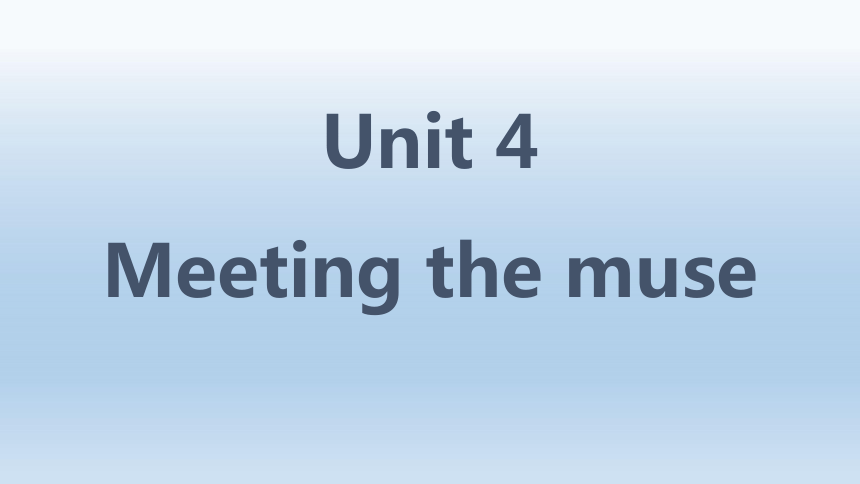 | |
| 格式 | pptx | ||
| 文件大小 | 54.7MB | ||
| 资源类型 | 教案 | ||
| 版本资源 | 外研版(2019) | ||
| 科目 | 英语 | ||
| 更新时间 | 2021-12-14 10:36:35 | ||
图片预览

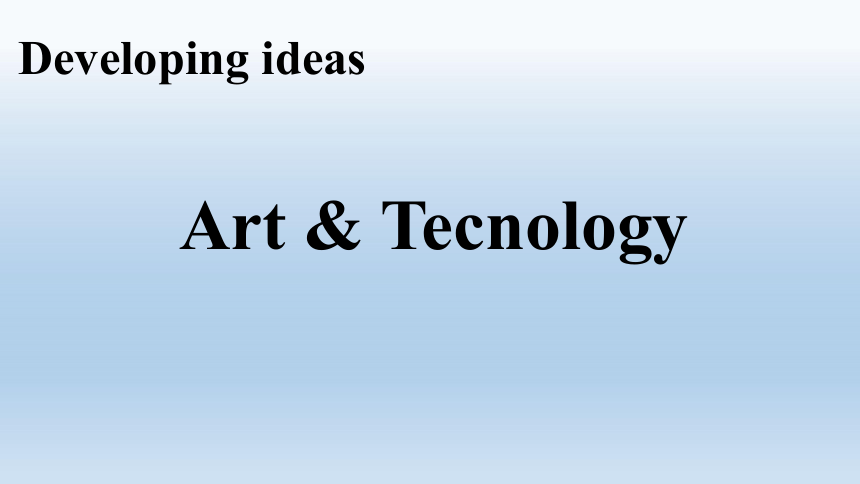
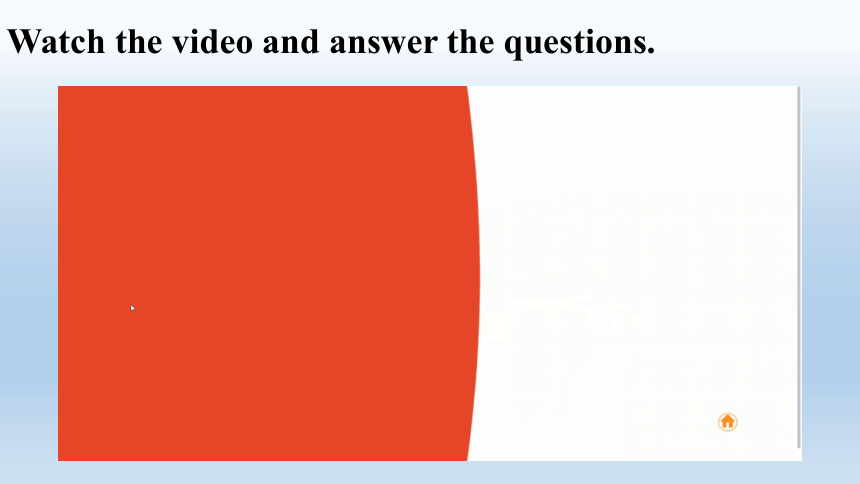
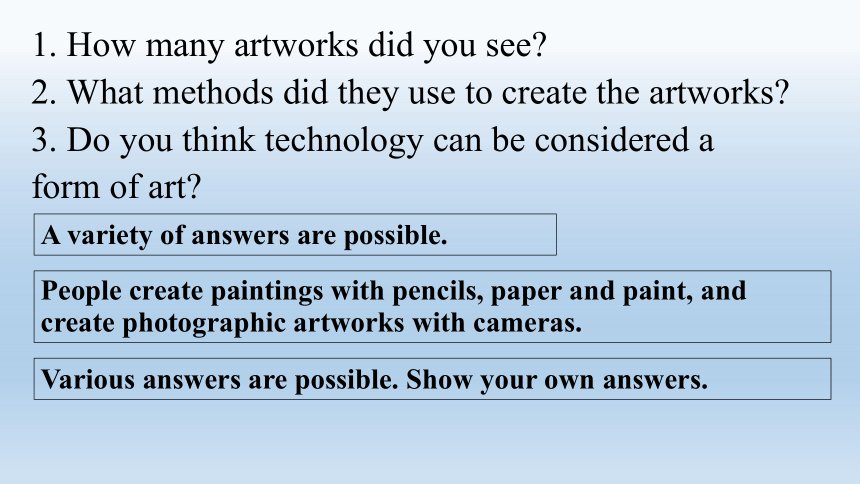
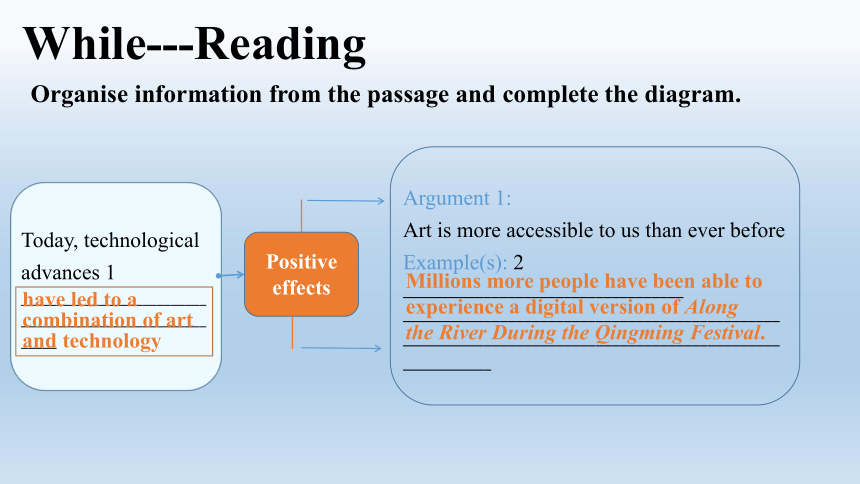
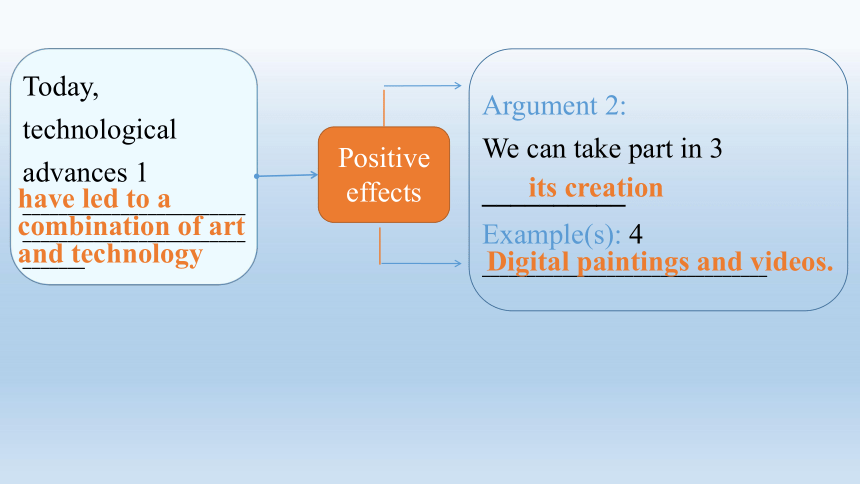
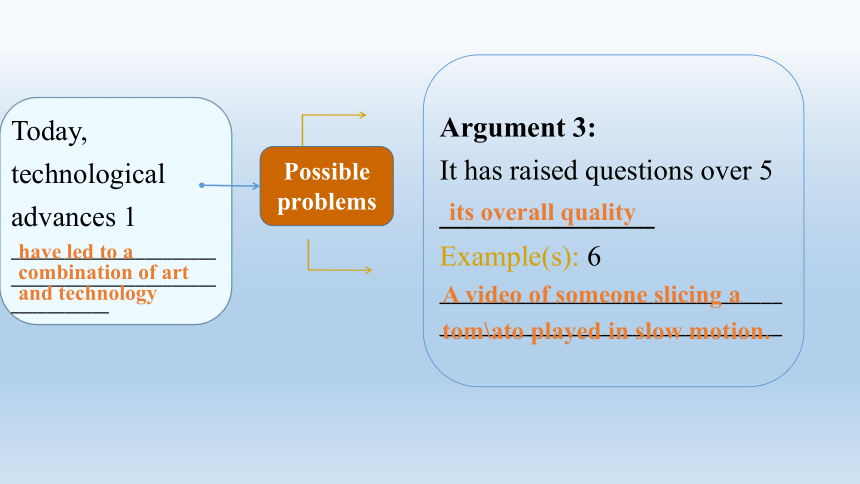
文档简介
(共17张PPT)
Unit 4
Meeting the muse
Art & Tecnology
Developing ideas
Watch the video and answer the questions.
1. How many artworks did you see
2. What methods did they use to create the artworks
3. Do you think technology can be considered a form of art
A variety of answers are possible.
People create paintings with pencils, paper and paint, and create photographic artworks with cameras.
Various answers are possible. Show your own answers.
While---Reading
Organise information from the passage and complete the diagram.
Positive effects
Today, technological advances 1 _________________________________________________________
Argument 1:
Art is more accessible to us than ever before
Example(s): 2 ___________________________________
_________________________________________________________________________________________________________
Millions more people have been able to experience a digital version of Along the River During the Qingming Festival.
have led to a combination of art and technology
Argument 2:
We can take part in 3 __________
Example(s): 4 ________________________________
its creation
Digital paintings and videos.
Today, technological advances 1 _________________________________________________________
Positive effects
have led to a combination of art and technology
Argument 3:
It has raised questions over 5 _______________
Example(s): 6 ________________________________
________________________________
Possible problems
Today, technological advances 1 _________________________________________________________
its overall quality
A video of someone slicing a tom\ato played in slow motion.
have led to a combination of art and technology
Possible problems
Today, technological advances 1 _________________________________________________________
Argument 4:
Such developments are 7 __________________________________________________________
Example(s): 8 ___________________________________
___________________________________
A new “Rembrandt painting” printed in 3D.
making the line between art and technology less distinct
have led to a combination of art and technology
We don’t know 9 ________________________________________________
but we can 10 ________________________________________________
Positive effects
Today, technological advances 1 _________________________________________________________
Possible problems
have led to a combination of art and technology
where technology will take art next
definitely expect the unexpected
Think & Share
1. What effect do you think technology will have on art in the future?
2. Do you know of any artworks created mainly by technology Share an example with the class.
3. What work of art can you create with the help of technology
4. Which of the two reading passages in this unit, both about the artists’ inspiration, do you prefer Why
Art is more accessible to us than ever before.
It’s a dancing pattern of lights. The artworks by American artist Janet Echelman look like colourful floating clouds when they are lit up at night. Visitors to one of her artworks in Vancouver could not only enjoy looking at it, they could also interact with it — literally.
Take for example one of China’s most famous paintings from the Song Dynasty, Along the River During the Qingming Festival. Thanks to technology, millions more people have been able to experience a digital version of this painting.
Various answers are possible.
Possible answers:
Work in groups. Hold a debate on whether technology has had a positive effect on art.
1. Divide each group in half. Each half takes a side in the debate.
2. Do further research to find more arguments and supporting examples besides those in the passage.
3. Organize your ideas from the most important to the least important.
4. Hold the debate.
Presentation--Vote for a group member who performs the best. Share their experience .
Language points
a form of
compare…with…
look like
light up
interact with
a variety of
be labelled as
be seen as
lead to
a combination of…
一种……形成
把…和…进行比较
看起来像
点亮
与…互动
各种各样的
被贴上…的标签
被视为…
导致
和…结合
be accessible to
take for (an)example
be rarely on display
up to
take in
thanks to
a digital version of
from daylight into nighttime
take part in
at one’s fingertips
易为…接触到
以…为例
极少被展出
高达
欣赏;领会
多亏,幸亏,由于
…的数字
白天到晚上
参加,参与
手头上有…随时可用
such as
the/an increase in…
raise questions over
in slow motion
the line between …and…
be unfamiliar to sb
end result
bring sb closer to
for sure
expect the unexpected
例如
…的增加
对…产生疑问
以慢动作
之间的…和 …界限
对某物不熟悉
最终结果
让某人更接近…
确定,肯定
期待意想不到的事情
than ever before
have a positive effect on
take a side
do further research
vote for
request the honour of your presence
one hundred of …
make sth out of
reply to confirm
rather than
make…improvement in doing
solve a problem/problems
比以往任何时候
对…产生积极影响
持一方立场;拥护;偏袒
做进一步的研究
投票支持
邀请阁下出席…
…的一百(个)
用…制作某物
回复确认…
而不是
在做某事物方面有…进步
解决问题
Whatever your opinion, people have been expressing their thoughts and ideas through art for thousands of years.无论你的看法如何,数千年来人们一直通过艺术表达自己的思想和理念。
Three-dimensional (3D) animation means that viewers can see the characters move around and interact with their surroundings. 利用3D动画技术,观赏者可以看到画中的人物四处走动并与周围事物互动。
Not only can we interact with art, but also take part in its creation. 我们不仅可以与艺术作品互动,还可以参与艺术作品的创作。
With new technological tools at our fingertips, more and more people are exploring their creative sides.通过触手可及的新兴科技工具,越来越多的人开始发掘自己创新的一面
A recent project used technology and data in the same way that Rembrandt used his paints and brushes. 最近有一个项目用科技手段和数据还原了伦勃朗的绘画方式。
The end result, printed in 3D, was a new “Rembrandt painting” created 347 years after the artist’s death. 最终,通过3D打印技术,在这位艺术家去世347年后,一幅全新的“伦勃朗画作”诞生了。
These advances are perhaps bringing us closer to a time when computers rather than humans create art.这些先进的技术正带领我们走进一个由电脑而非人类创造艺术的时代。
Where technology will take art next is anyone’s guess.科技将会推动艺术发展至何种地步,我们不得而知。
Unit 4
Meeting the muse
Art & Tecnology
Developing ideas
Watch the video and answer the questions.
1. How many artworks did you see
2. What methods did they use to create the artworks
3. Do you think technology can be considered a form of art
A variety of answers are possible.
People create paintings with pencils, paper and paint, and create photographic artworks with cameras.
Various answers are possible. Show your own answers.
While---Reading
Organise information from the passage and complete the diagram.
Positive effects
Today, technological advances 1 _________________________________________________________
Argument 1:
Art is more accessible to us than ever before
Example(s): 2 ___________________________________
_________________________________________________________________________________________________________
Millions more people have been able to experience a digital version of Along the River During the Qingming Festival.
have led to a combination of art and technology
Argument 2:
We can take part in 3 __________
Example(s): 4 ________________________________
its creation
Digital paintings and videos.
Today, technological advances 1 _________________________________________________________
Positive effects
have led to a combination of art and technology
Argument 3:
It has raised questions over 5 _______________
Example(s): 6 ________________________________
________________________________
Possible problems
Today, technological advances 1 _________________________________________________________
its overall quality
A video of someone slicing a tom\ato played in slow motion.
have led to a combination of art and technology
Possible problems
Today, technological advances 1 _________________________________________________________
Argument 4:
Such developments are 7 __________________________________________________________
Example(s): 8 ___________________________________
___________________________________
A new “Rembrandt painting” printed in 3D.
making the line between art and technology less distinct
have led to a combination of art and technology
We don’t know 9 ________________________________________________
but we can 10 ________________________________________________
Positive effects
Today, technological advances 1 _________________________________________________________
Possible problems
have led to a combination of art and technology
where technology will take art next
definitely expect the unexpected
Think & Share
1. What effect do you think technology will have on art in the future?
2. Do you know of any artworks created mainly by technology Share an example with the class.
3. What work of art can you create with the help of technology
4. Which of the two reading passages in this unit, both about the artists’ inspiration, do you prefer Why
Art is more accessible to us than ever before.
It’s a dancing pattern of lights. The artworks by American artist Janet Echelman look like colourful floating clouds when they are lit up at night. Visitors to one of her artworks in Vancouver could not only enjoy looking at it, they could also interact with it — literally.
Take for example one of China’s most famous paintings from the Song Dynasty, Along the River During the Qingming Festival. Thanks to technology, millions more people have been able to experience a digital version of this painting.
Various answers are possible.
Possible answers:
Work in groups. Hold a debate on whether technology has had a positive effect on art.
1. Divide each group in half. Each half takes a side in the debate.
2. Do further research to find more arguments and supporting examples besides those in the passage.
3. Organize your ideas from the most important to the least important.
4. Hold the debate.
Presentation--Vote for a group member who performs the best. Share their experience .
Language points
a form of
compare…with…
look like
light up
interact with
a variety of
be labelled as
be seen as
lead to
a combination of…
一种……形成
把…和…进行比较
看起来像
点亮
与…互动
各种各样的
被贴上…的标签
被视为…
导致
和…结合
be accessible to
take for (an)example
be rarely on display
up to
take in
thanks to
a digital version of
from daylight into nighttime
take part in
at one’s fingertips
易为…接触到
以…为例
极少被展出
高达
欣赏;领会
多亏,幸亏,由于
…的数字
白天到晚上
参加,参与
手头上有…随时可用
such as
the/an increase in…
raise questions over
in slow motion
the line between …and…
be unfamiliar to sb
end result
bring sb closer to
for sure
expect the unexpected
例如
…的增加
对…产生疑问
以慢动作
之间的…和 …界限
对某物不熟悉
最终结果
让某人更接近…
确定,肯定
期待意想不到的事情
than ever before
have a positive effect on
take a side
do further research
vote for
request the honour of your presence
one hundred of …
make sth out of
reply to confirm
rather than
make…improvement in doing
solve a problem/problems
比以往任何时候
对…产生积极影响
持一方立场;拥护;偏袒
做进一步的研究
投票支持
邀请阁下出席…
…的一百(个)
用…制作某物
回复确认…
而不是
在做某事物方面有…进步
解决问题
Whatever your opinion, people have been expressing their thoughts and ideas through art for thousands of years.无论你的看法如何,数千年来人们一直通过艺术表达自己的思想和理念。
Three-dimensional (3D) animation means that viewers can see the characters move around and interact with their surroundings. 利用3D动画技术,观赏者可以看到画中的人物四处走动并与周围事物互动。
Not only can we interact with art, but also take part in its creation. 我们不仅可以与艺术作品互动,还可以参与艺术作品的创作。
With new technological tools at our fingertips, more and more people are exploring their creative sides.通过触手可及的新兴科技工具,越来越多的人开始发掘自己创新的一面
A recent project used technology and data in the same way that Rembrandt used his paints and brushes. 最近有一个项目用科技手段和数据还原了伦勃朗的绘画方式。
The end result, printed in 3D, was a new “Rembrandt painting” created 347 years after the artist’s death. 最终,通过3D打印技术,在这位艺术家去世347年后,一幅全新的“伦勃朗画作”诞生了。
These advances are perhaps bringing us closer to a time when computers rather than humans create art.这些先进的技术正带领我们走进一个由电脑而非人类创造艺术的时代。
Where technology will take art next is anyone’s guess.科技将会推动艺术发展至何种地步,我们不得而知。
